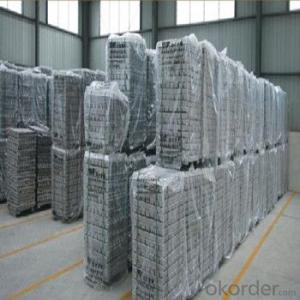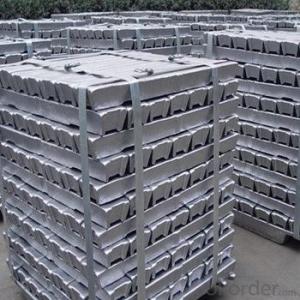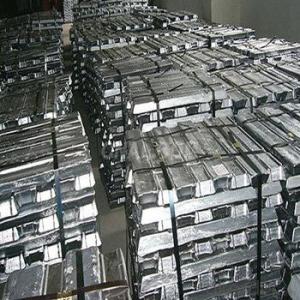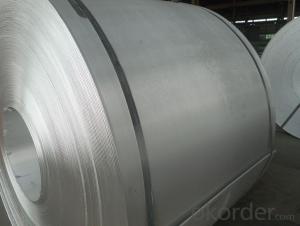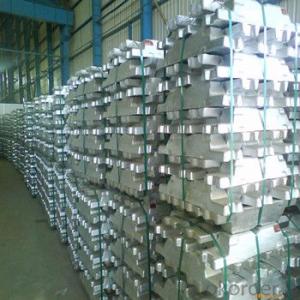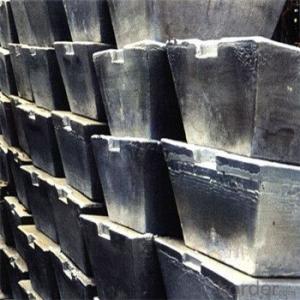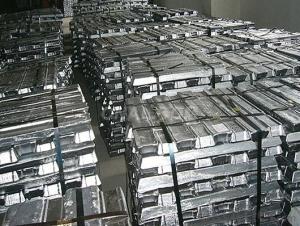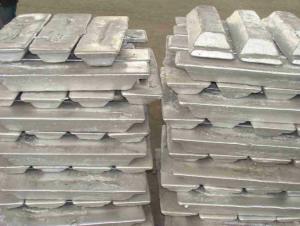Aluminum Ingot From Chinese Supplier Best Quanlity
- Loading Port:
- China main port
- Payment Terms:
- TT OR LC
- Min Order Qty:
- 1000 m.t.
- Supply Capability:
- 10000 m.t./month
OKorder Service Pledge
OKorder Financial Service
You Might Also Like
Pure Aluminum Ingot Used for Industry
1.Structure of Aluminum Ingot Description
An ingot is a piece of material, usually metal, that is cast into a shape suitable for further processing. Insteelmaking, it is the first step among semi-finished casting products.
2.Main Features of the Aluminum Ingot
•Easy control and operation
•Fast melting
•Good price
•Good Service
3. Aluminum Ingot Images
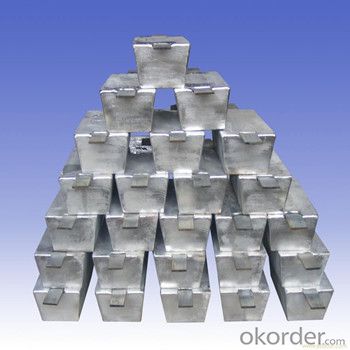
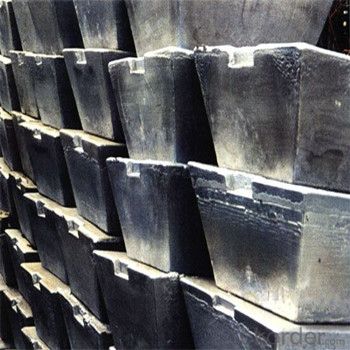
4. Aluminum Ingot Specification
Grade | Chemical Composition % | |||||||||
Al≥ | impurities ≤ | |||||||||
Si | Fe | Cu | Ga | Mg | Zn | Mn | others | Sum | ||
Al99.9 | 99.90 | 0.50 | 0.07 | 0.005 | 0.02 | 0.01 | 0.025 | - | 0.010 | 0.10 |
Al99.85 | 99.85 | 0.80 | 0.12 | 0.005 | 0.03 | 0.02 | 0.030 | - | 0.015 | 0.15 |
Al99.7 | 99.70 | 0.10 | 0.20 | 0.010 | 0.03 | 0.02 | 0.030 | - | 0.030 | 0.30 |
Al99.6 | 99.60 | 0.16 | 0.25 | 0.010 | 0.03 | 0.03 | 0.030 | - | 0.030 | 0.40 |
Al99.5 | 99.50 | 0.22 | 0.30 | 0.020 | 0.03 | 0.05 | 0.050 | - | 0.030 | 0.50 |
Al99.00 | 99.00 | 0.42 | 0.50 | 0.020 | 0.03 | 0.05 | 0.050 | - | 0.050 | 1.00 |
5.FAQ of Aluminum Ingot
We have organized several common questions for our clients,may help you sincerely:
①How about your company?
A world class manufacturer & supplier of castings forging in carbon steel and alloy steel,is one of the large-scale professional investment casting production bases in China,consisting of both casting foundry forging and machining factory. Annually more than 8000 tons Precision casting and forging parts are exported to markets in Europe,America and Japan. OEM casting and forging service available according to customer’s requirements.
②How to guarantee the quality of the products?
We have established the international advanced quality management system,every link from raw material to final product we have strict quality test;We resolutely put an end to unqualified products flowing into the market. At the same time, we will provide necessary follow-up service assurance.
③How long can we receive the product after purchase?
In the purchase of product within three working days, We will arrange the factory delivery as soon as possible. The pecific time of receiving is related to the state and position of customers.Commonly 7 to 10 working days can be served.
- Q:What are the environmental benefits of using aluminum ingots?
- There are several environmental benefits associated with using aluminum ingots. Firstly, aluminum is a highly recyclable material. In fact, it is one of the most recycled materials in the world. By using aluminum ingots, we can promote a circular economy where the material can be reused and repurposed without significant degradation in quality. This reduces the need for extracting and processing new aluminum from bauxite ore, which requires significant energy and contributes to carbon emissions. Recycling aluminum ingots greatly reduces the energy and carbon footprint associated with its production. Furthermore, aluminum ingots have a relatively low weight compared to other materials, such as steel. This lightweight characteristic is advantageous in various industries, particularly automotive and aerospace. By using aluminum ingots instead of heavier materials, vehicles and aircraft can achieve better fuel efficiency, leading to reduced greenhouse gas emissions. Additionally, the lightweight nature of aluminum ingots allows for easier transportation and reduces fuel consumption during the logistics process. Another environmental benefit of using aluminum ingots is their resistance to corrosion. Aluminum naturally forms a protective oxide layer that helps prevent rust and degradation, making it highly durable and long-lasting. This means that products made from aluminum ingots, such as building materials or consumer goods, have a longer lifespan and require less frequent replacement. This reduces the overall demand for raw materials and minimizes waste generation. Lastly, aluminum ingots can contribute to energy savings in buildings. Aluminum is an excellent conductor of heat and electricity, allowing for efficient thermal management in construction. By using aluminum ingots in windows, doors, and other building components, energy consumption for heating and cooling can be reduced, leading to lower carbon emissions and decreased reliance on fossil fuels. In conclusion, the environmental benefits of using aluminum ingots include its recyclability, lightweight nature, corrosion resistance, and energy efficiency. By incorporating aluminum ingots into various industries and products, we can promote sustainability, reduce carbon emissions, and conserve natural resources.
- Q:What are the challenges in recycling aluminum ingots?
- Recycling aluminum ingots presents several challenges that need to be addressed. To begin with, a major obstacle is the collection and sorting of aluminum waste. Unlike paper or plastic, aluminum waste is often mixed with other materials, making separation and sorting difficult. This necessitates the use of advanced sorting technologies and manual labor, which can be time-consuming and expensive. Additionally, the energy-intensive nature of aluminum production poses a challenge. Although recycling aluminum requires less energy than primary production, it still requires a significant amount of electricity. The process of melting down and purifying aluminum ingots requires high temperatures, which consume a considerable amount of energy. Furthermore, contamination is a persistent issue in recycling aluminum ingots. Even with advanced sorting technologies, it is difficult to guarantee that recycled aluminum is free from impurities. Contaminants like paint, coatings, or other metals can negatively impact the quality of the final product, making it less appealing to manufacturers. Moreover, transportation logistics present another challenge in the recycling process. Aluminum ingots are heavy and bulky, making their transportation from collection centers to recycling plants costly and challenging. This adds to the overall expenses of recycling. Lastly, the global market demand for recycled aluminum can fluctuate, making it challenging for recyclers to find buyers for their ingots. Economic factors, such as the price of primary aluminum and the demand for recycled materials in the market, can impact the profitability and feasibility of recycling aluminum ingots. Despite these challenges, recycling aluminum ingots remains a crucial practice due to its environmental benefits and the conservation of valuable resources. Continued research and innovation in recycling technologies can help overcome these challenges and make the process more efficient and cost-effective.
- Q:How are aluminum ingots used in the production of electronic devices?
- Aluminum ingots find various applications in the manufacturing of electronic devices. To begin with, aluminum, being a lightweight and robust metal, is an ideal choice for producing casings or housings for electronic devices. These ingots are melted and cast into specific shapes to form the outer shells of smartphones, laptops, tablets, and even gaming consoles. Moreover, aluminum possesses exceptional conductivity for both electricity and heat. Consequently, it is frequently employed as a heat sink material in electronic devices to dissipate excess heat generated during operation. The ingots are processed into heat sinks, which are then incorporated into components like processors, graphics cards, and power modules. The high thermal conductivity of aluminum aids in maintaining optimal operating temperatures, preventing overheating, and ensuring the longevity and performance of electronic devices. Furthermore, aluminum ingots are also utilized in the production of printed circuit boards (PCBs). PCBs serve as the foundation for assembling and connecting various electronic components, making them essential for electronic devices. Aluminum is used as a base material for manufacturing PCBs due to its mechanical strength and electrical insulation properties. The ingots are processed into thin sheets that function as the base substrate for mounting electronic components, establishing a solid foundation for the functionality of the devices. In conclusion, aluminum ingots play a vital role in the production of electronic devices. They are employed in creating lightweight and durable casings, heat sinks for effective thermal management, and base materials for PCBs. With its exceptional electrical conductivity, heat dissipation capabilities, and mechanical strength, aluminum significantly contributes to the overall performance, reliability, and efficiency of electronic devices.
- Q:What are the advantages of using aluminum ingots in the production of automotive lightweighting solutions?
- There are several advantages of using aluminum ingots in the production of automotive lightweighting solutions. Firstly, aluminum is a lightweight material, which helps in reducing the overall weight of the vehicle. This leads to improved fuel efficiency and reduced emissions. Additionally, aluminum has excellent strength and durability properties, making it suitable for automotive applications. It can withstand harsh operating conditions and provide a high level of safety. Moreover, aluminum is highly corrosion-resistant, prolonging the lifespan of the vehicle. Lastly, aluminum is a recyclable material, making it environmentally friendly and contributing to sustainable manufacturing processes. Overall, the use of aluminum ingots in automotive lightweighting solutions offers various benefits in terms of performance, efficiency, safety, and sustainability.
- Q:How are aluminum ingots used in the production of electrical connectors?
- Aluminum ingots are used in the production of electrical connectors as they provide a lightweight and durable material that is essential for efficient and reliable electrical connections. The ingots are melted down and cast into different connector shapes, ensuring the desired conductivity and strength. Aluminum's high electrical conductivity allows for efficient transmission of electricity, while its corrosion resistance ensures longevity of the connectors. These ingots are also easily malleable, allowing for precise shaping and customization of connectors to meet various electrical requirements.
- Q:What is the difference between a aluminium ingot with and without a ticket?
- Beijing's purchase price is the price of aluminum, aluminum ingot + processing fees, billing is generally not a ton of processing fee will be about 400 yuan less, your price is overall, the overall profits can be, I think do not have to manage open ballot problem of aluminum ingots.
- Q:How are aluminum ingots inspected for quality?
- The quality of aluminum ingots is assessed through a comprehensive and methodical process. This process entails visual examination, dimensional measurements, and the utilization of different testing methods. To begin with, inspectors who have received training meticulously inspect the ingots to identify any surface defects such as cracks, dents, or impurities. Their close examination ensures that the ingots meet the necessary standards. Next, precise instruments like calipers or digital measuring devices are employed to measure the size and weight of the ingots. This involves checking the length, width, height, and weight of each ingot and comparing these measurements with the specified tolerances to ensure compliance. Furthermore, in addition to visual inspection and dimensional measurements, various testing methods are utilized to evaluate the mechanical properties and chemical composition of the aluminum ingots. These tests include hardness testing, tensile strength testing, impact testing, and spectroscopic analysis. Hardness testing gauges the ingot's resistance to indentation or deformation, providing insights into its strength. Tensile strength testing measures the maximum stress the ingot can endure before breaking. Impact testing evaluates the ingot's ability to absorb energy under sudden loading conditions. These tests aid in identifying any weaknesses or inconsistencies in the mechanical properties of the ingot. Moreover, spectroscopic analysis is employed to determine the chemical composition of the ingots. This analysis involves examining the elements present in the aluminum alloy and comparing them with the specified composition. It guarantees that the desired alloying elements are present in the correct proportions, ensuring the suitability of the ingots for specific applications. In conclusion, the evaluation of aluminum ingots for quality entails a combination of visual examination, dimensional measurements, and various testing methods. By adhering to these rigorous quality control procedures, manufacturers can ensure that the aluminum ingots delivered to customers meet the required standards and possess superior quality.
- Q:Can aluminum ingots be anodized?
- Yes, aluminum ingots can be anodized. Anodizing is a process that involves creating an oxide layer on the surface of aluminum, which can be done on both raw aluminum and aluminum alloys. This process enhances the metal's corrosion resistance, improves its appearance, and allows for coloring or dyeing options.
- Q:Sincerely ask predecessors to tell me about the processing of aluminum ingots to doors and windows, curtain walls, aluminum profiles, the general process and about the process!
- The first cast aluminum rod, generally with the same level hot top casting equipment, casting equipment Woge Gustave America more now.
- Q:What are the different grades of aluminum ingots?
- There are several different grades of aluminum ingots, each with specific properties and uses. The most commonly recognized grades include: 1. Pure Aluminum (99%+): This grade is the most basic form of aluminum and is highly malleable, lightweight, and corrosion-resistant. It is often used in applications where high electrical conductivity is required, such as electrical wiring and transmission lines. 2. Aluminum Alloys: These grades are composed of aluminum combined with other elements, such as copper, magnesium, silicon, or zinc, to enhance specific properties. For example, aluminum alloys with copper are known for their excellent strength and corrosion resistance, making them ideal for structural components in aerospace or automotive industries. 3. Cast Aluminum: This grade is produced by the casting process and is typically used for manufacturing engine parts, automotive wheels, and other heavy-duty applications where strength and durability are crucial. 4. Wrought Aluminum: Wrought aluminum ingots undergo a shaping process, such as rolling or extrusion, to create specific forms like sheets, plates, or bars. This grade is commonly used in the construction industry for structural elements like beams, columns, and facade systems. 5. High-Strength Aluminum: These grades are engineered to have superior strength while maintaining good formability. They are often employed in industries where lightweight, yet sturdy materials are required, such as aerospace, military, or sporting goods manufacturing. It's important to note that these grades can further be categorized into specific alloys, each with its own unique characteristics and applications. The choice of aluminum grade depends on the intended use, desired properties, and manufacturing requirements of the final product.
1. Manufacturer Overview |
|
|---|---|
| Location | |
| Year Established | |
| Annual Output Value | |
| Main Markets | |
| Company Certifications | |
2. Manufacturer Certificates |
|
|---|---|
| a) Certification Name | |
| Range | |
| Reference | |
| Validity Period | |
3. Manufacturer Capability |
|
|---|---|
| a)Trade Capacity | |
| Nearest Port | |
| Export Percentage | |
| No.of Employees in Trade Department | |
| Language Spoken: | |
| b)Factory Information | |
| Factory Size: | |
| No. of Production Lines | |
| Contract Manufacturing | |
| Product Price Range | |
Send your message to us
Aluminum Ingot From Chinese Supplier Best Quanlity
- Loading Port:
- China main port
- Payment Terms:
- TT OR LC
- Min Order Qty:
- 1000 m.t.
- Supply Capability:
- 10000 m.t./month
OKorder Service Pledge
OKorder Financial Service
Similar products
New products
Hot products
Hot Searches
Related keywords
